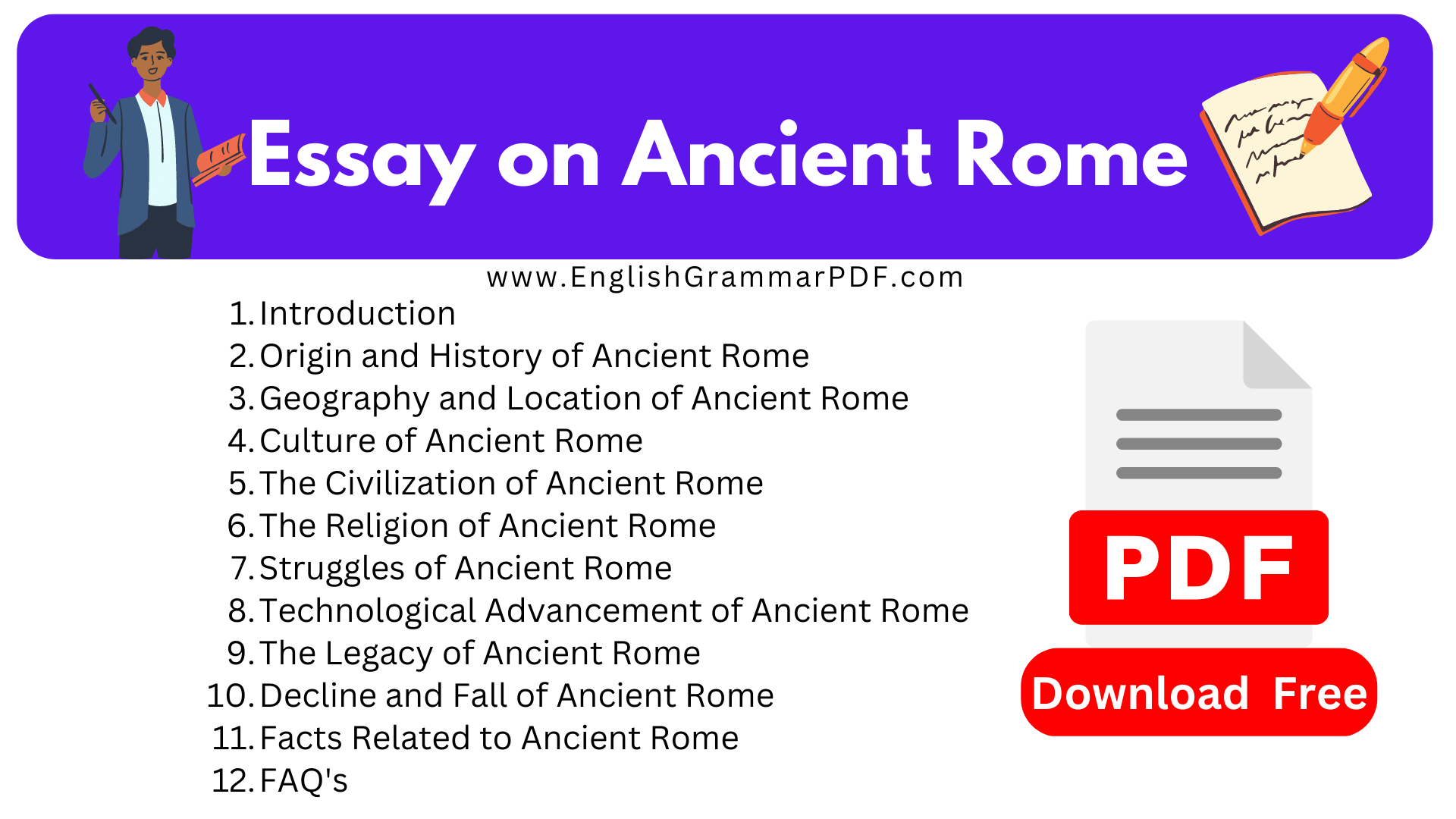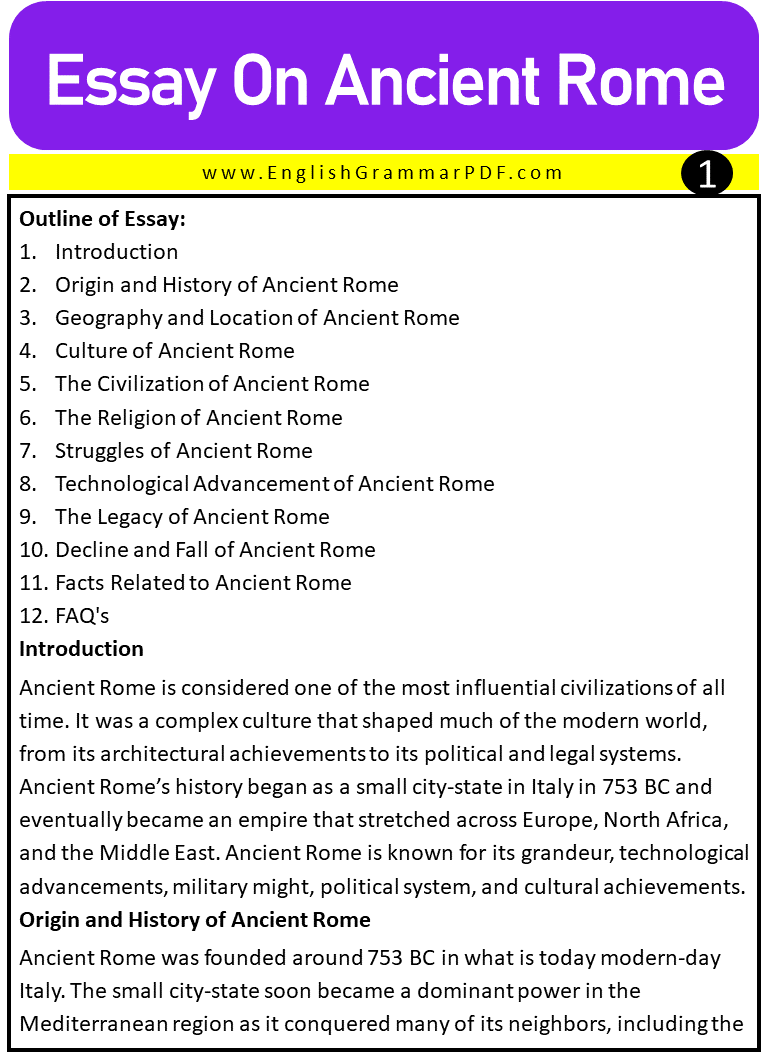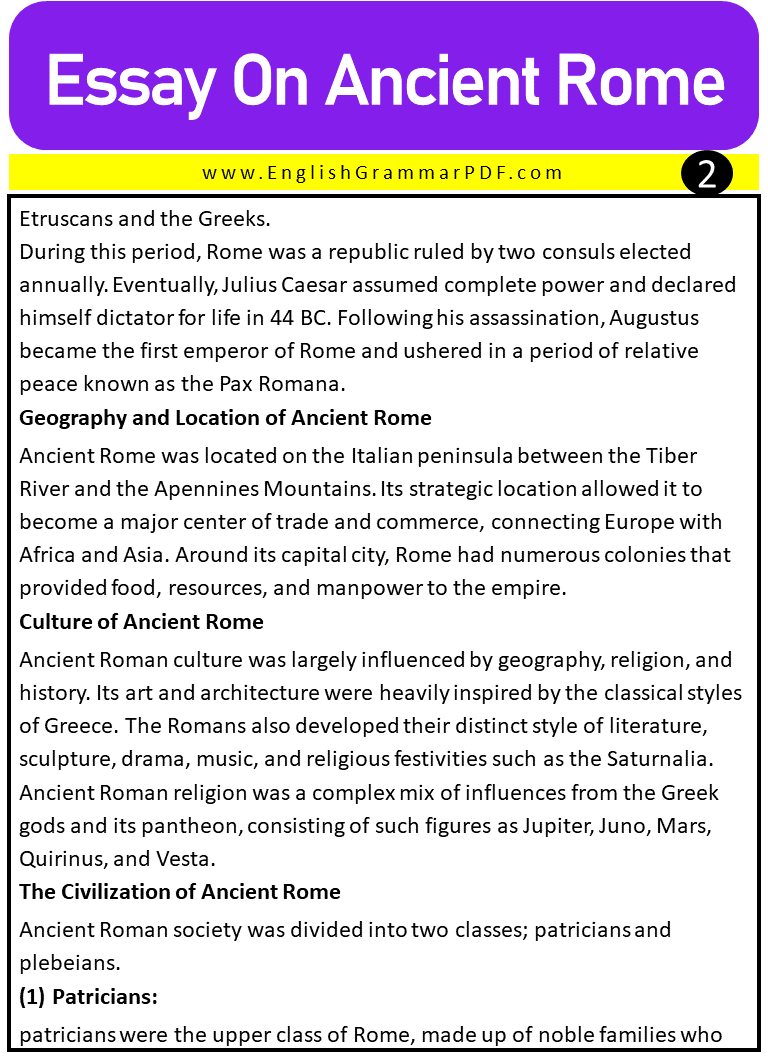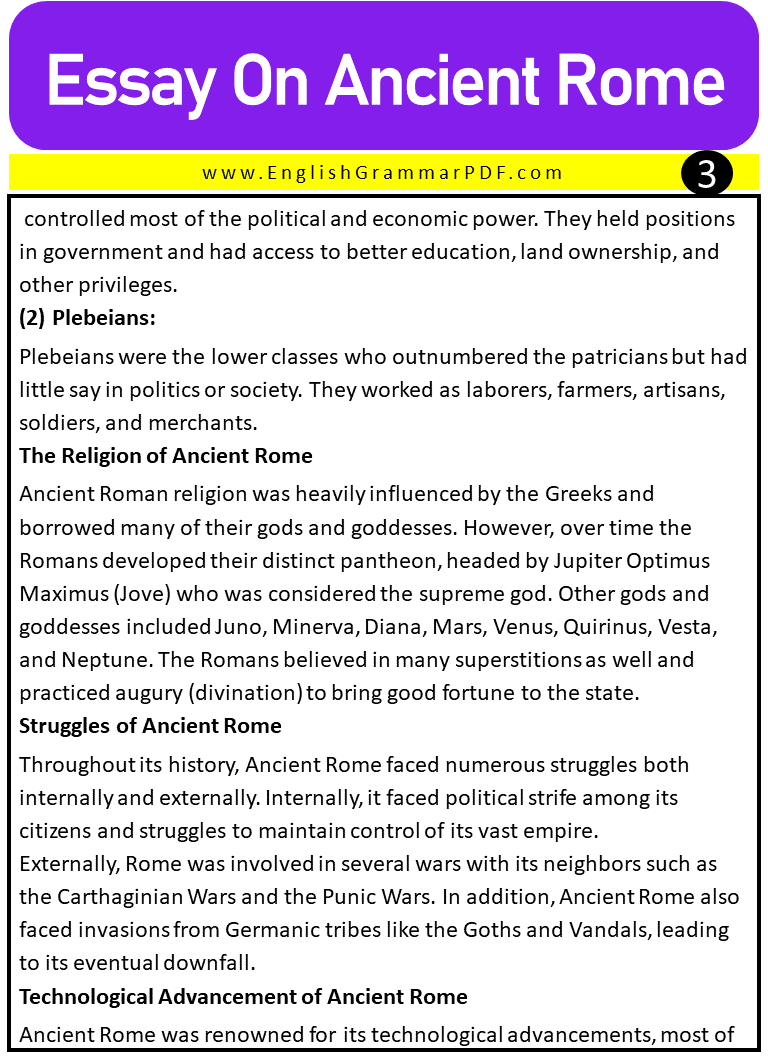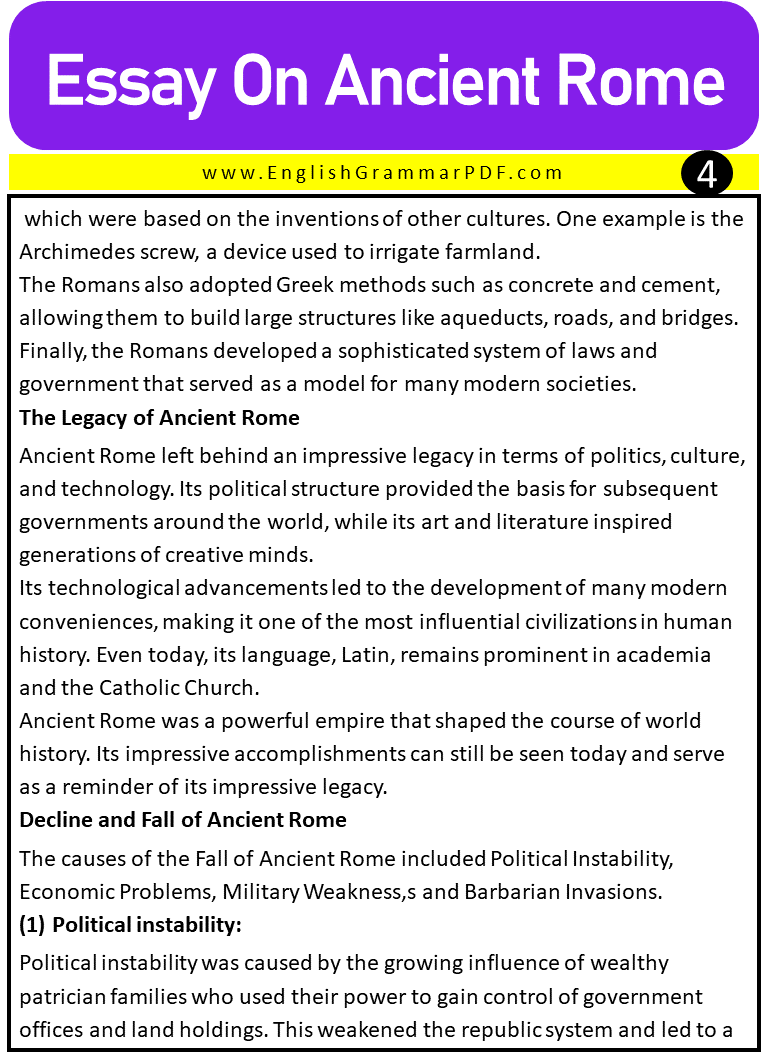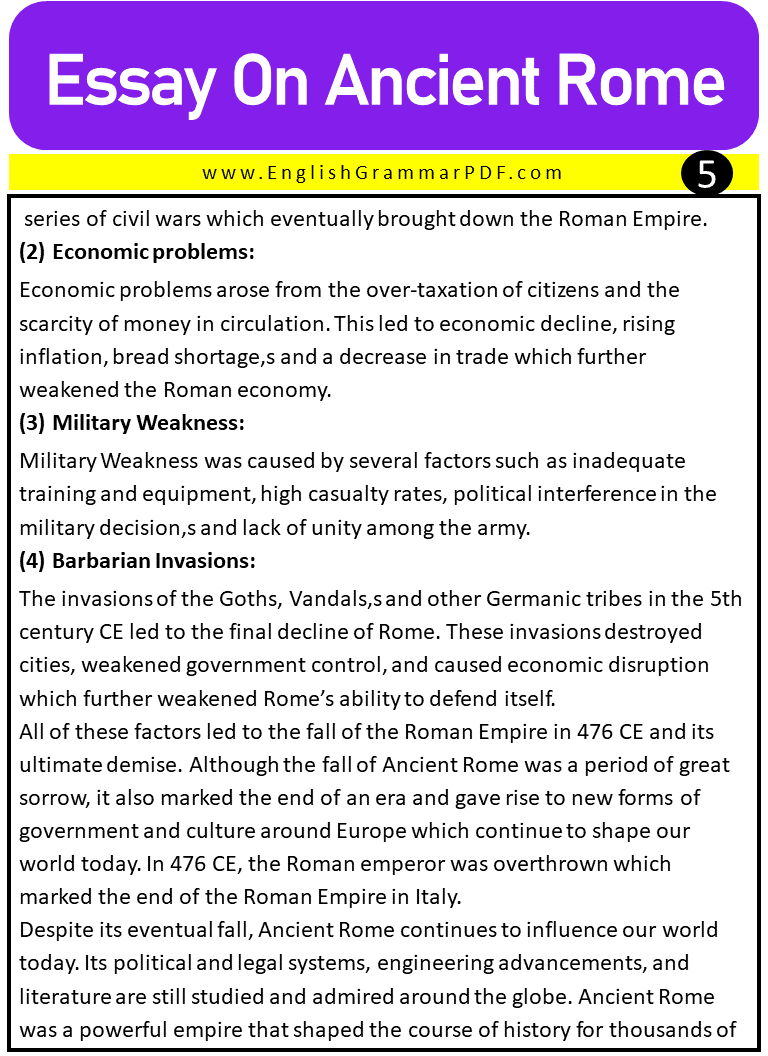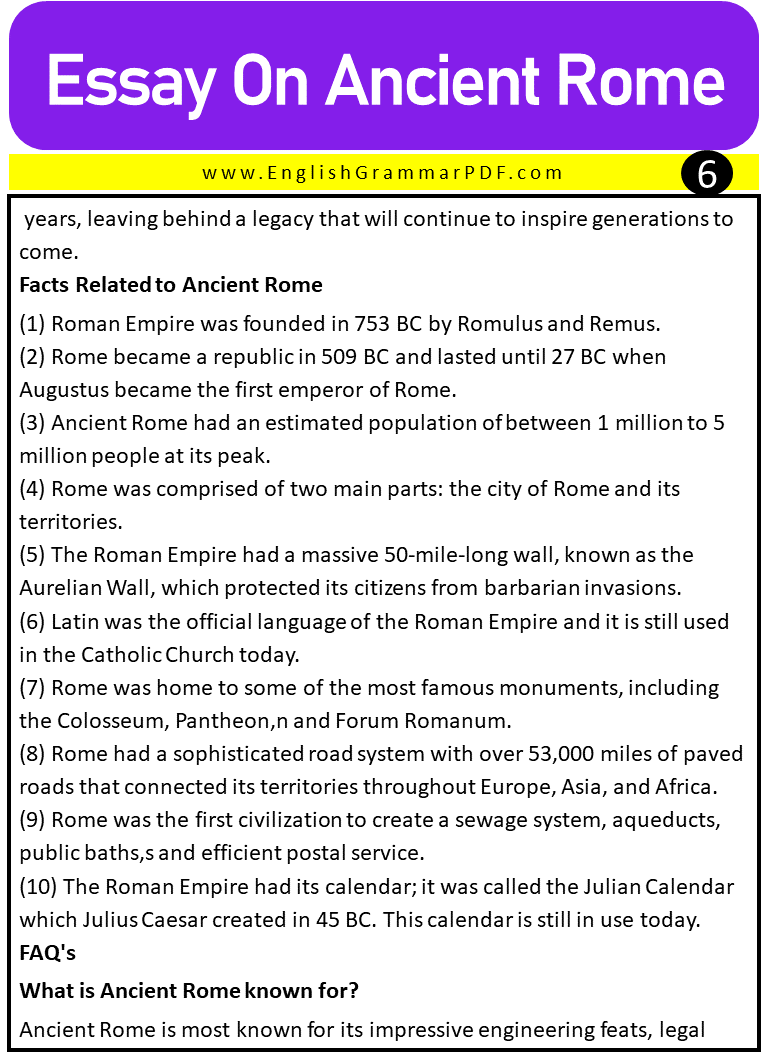Essay On Ancient Rome
Outline of Essay:
- Introduction
- Origin and History of Ancient Rome
- Geography and Location of Ancient Rome
- Culture of Ancient Rome
- The Civilization of Ancient Rome
- The Religion of Ancient Rome
- Struggles of Ancient Rome
- Technological Advancement of Ancient Rome
- The Legacy of Ancient Rome
- Decline and Fall of Ancient Rome
- Facts Related to Ancient Rome
- FAQ’s
Discover More:
Introduction
Ancient Rome is considered one of the most influential civilizations of all time. It was a complex culture that shaped much of the modern world, from its architectural achievements to its political and legal systems. Ancient Rome’s history began as a small city-state in Italy in 753 BC and eventually became an empire that stretched across Europe, North Africa, and the Middle East. Ancient Rome is known for its grandeur, technological advancements, military might, political system, and cultural achievements.
Origin and History of Ancient Rome
Ancient Rome was founded around 753 BC in what is today modern-day Italy. The small city-state soon became a dominant power in the Mediterranean region as it conquered many of its neighbors, including the Etruscans and the Greeks.
During this period, Rome was a republic ruled by two consuls elected annually. Eventually, Julius Caesar assumed complete power and declared himself dictator for life in 44 BC. Following his assassination, Augustus became the first emperor of Rome and ushered in a period of relative peace known as the Pax Romana.
Geography and Location of Ancient Rome
Ancient Rome was located on the Italian peninsula between the Tiber River and the Apennines Mountains. Its strategic location allowed it to become a major center of trade and commerce, connecting Europe with Africa and Asia. Around its capital city, Rome had numerous colonies that provided food, resources, and manpower to the empire.
Culture of Ancient Rome
Ancient Roman culture was largely influenced by geography, religion, and history. Its art and architecture were heavily inspired by the classical styles of Greece. The Romans also developed their distinct style of literature, sculpture, drama, music, and religious festivities such as the Saturnalia. Ancient Roman religion was a complex mix of influences from the Greek gods and its pantheon, consisting of such figures as Jupiter, Juno, Mars, Quirinus, and Vesta.
The Civilization of Ancient Rome
Ancient Roman society was divided into two classes; patricians and plebeians.
(1) Patricians:
patricians were the upper class of Rome, made up of noble families who controlled most of the political and economic power. They held positions in government and had access to better education, land ownership, and other privileges.
(2) Plebeians:
Plebeians were the lower classes who outnumbered the patricians but had little say in politics or society. They worked as laborers, farmers, artisans, soldiers, and merchants.
The Religion of Ancient Rome
Ancient Roman religion was heavily influenced by the Greeks and borrowed many of their gods and goddesses. However, over time the Romans developed their distinct pantheon, headed by Jupiter Optimus Maximus (Jove) who was considered the supreme god. Other gods and goddesses included Juno, Minerva, Diana, Mars, Venus, Quirinus, Vesta, and Neptune. The Romans believed in many superstitions as well and practiced augury (divination) to bring good fortune to the state.
Struggles of Ancient Rome
Throughout its history, Ancient Rome faced numerous struggles both internally and externally. Internally, it faced political strife among its citizens and struggles to maintain control of its vast empire.
Externally, Rome was involved in several wars with its neighbors such as the Carthaginian Wars and the Punic Wars. In addition, Ancient Rome also faced invasions from Germanic tribes like the Goths and Vandals, leading to its eventual downfall.
Technological Advancement of Ancient Rome
Ancient Rome was renowned for its technological advancements, most of which were based on the inventions of other cultures. One example is the Archimedes screw, a device used to irrigate farmland.
The Romans also adopted Greek methods such as concrete and cement, allowing them to build large structures like aqueducts, roads, and bridges. Finally, the Romans developed a sophisticated system of laws and government that served as a model for many modern societies.
The Legacy of Ancient Rome
Ancient Rome left behind an impressive legacy in terms of politics, culture, and technology. Its political structure provided the basis for subsequent governments around the world, while its art and literature inspired generations of creative minds.
Its technological advancements led to the development of many modern conveniences, making it one of the most influential civilizations in human history. Even today, its language, Latin, remains prominent in academia and the Catholic Church.
Ancient Rome was a powerful empire that shaped the course of world history. Its impressive accomplishments can still be seen today and serve as a reminder of its impressive legacy.
Decline and Fall of Ancient Rome
The causes of the Fall of Ancient Rome included Political Instability, Economic Problems, Military Weakness,s and Barbarian Invasions.
(1) Political instability:
Political instability was caused by the growing influence of wealthy patrician families who used their power to gain control of government offices and land holdings. This weakened the republic system and led to a series of civil wars which eventually brought down the Roman Empire.
(2) Economic problems:
Economic problems arose from the over-taxation of citizens and the scarcity of money in circulation. This led to economic decline, rising inflation, bread shortage,s and a decrease in trade which further weakened the Roman economy.
(3) Military Weakness:
Military Weakness was caused by several factors such as inadequate training and equipment, high casualty rates, political interference in the military decision,s and lack of unity among the army.
(4) Barbarian Invasions:
The invasions of the Goths, Vandals,s and other Germanic tribes in the 5th century CE led to the final decline of Rome. These invasions destroyed cities, weakened government control, and caused economic disruption which further weakened Rome’s ability to defend itself.
All of these factors led to the fall of the Roman Empire in 476 CE and its ultimate demise. Although the fall of Ancient Rome was a period of great sorrow, it also marked the end of an era and gave rise to new forms of government and culture around Europe which continue to shape our world today. In 476 CE, the Roman emperor was overthrown which marked the end of the Roman Empire in Italy.
Despite its eventual fall, Ancient Rome continues to influence our world today. Its political and legal systems, engineering advancements, and literature are still studied and admired around the globe. Ancient Rome was a powerful empire that shaped the course of history for thousands of years, leaving behind a legacy that will continue to inspire generations to come.
Facts Related to Ancient Rome
(1) Roman Empire was founded in 753 BC by Romulus and Remus.
(2) Rome became a republic in 509 BC and lasted until 27 BC when Augustus became the first emperor of Rome.
(3) Ancient Rome had an estimated population of between 1 million to 5 million people at its peak.
(4) Rome was comprised of two main parts: the city of Rome and its territories.
(5) The Roman Empire had a massive 50-mile-long wall, known as the Aurelian Wall, which protected its citizens from barbarian invasions.
(6) Latin was the official language of the Roman Empire and it is still used in the Catholic Church today.
(7) Rome was home to some of the most famous monuments, including the Colosseum, Pantheon,n and Forum Romanum.
(8) Rome had a sophisticated road system with over 53,000 miles of paved roads that connected its territories throughout Europe, Asia, and Africa.
(9) Rome was the first civilization to create a sewage system, aqueducts, public baths,s and efficient postal service.
(10) The Roman Empire had its calendar; it was called the Julian Calendar which Julius Caesar created in 45 BC. This calendar is still in use today.
FAQ’s
What is Ancient Rome known for?
Ancient Rome is most known for its impressive engineering feats, legal system of law,s and political structure. It was also home to some of the greatest monuments such as the Colosseum, Pantheon,n and Forum Romanum.
When did Ancient Rome fall?
Ancient Rome fell in 476 CE when the emperor was overthrown by Odoacer, a Germanic chieftain.
What caused the fall of Ancient Rome?
The fall of Ancient Rome was due to a combination of factors such as political instability, economic decline, military weakness,s, and barbarian invasions. These factors combined to weaken the Roman Empire which eventually led to its downfall in 476 CE.
Where is Ancient Rome now?
Ancient Rome is now located in modern-day Italy, where its ruins and monuments remain.
What was the language of Ancient Rome?
The official language of Ancient Rome was Latin which is still used today in the Catholic Church.
Why was Rome so special?
Rome was special because it was the first civilization to create a sewage system, aqueducts, public baths,s and efficient postal service. It also had a sophisticated road system with over 53,000 miles of paved roads connecting its territories throughout Europe, Asia, and Africa.
Download PDF of Essay On Ancient Rome
